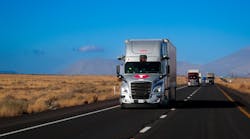California’s AB 316 pushes cleaner, safer highways into next decade
Much of the autonomous trucking technology to move freight without humans behind the wheel is being developed in California's Silicon Valley. Despite pushback from the governor, Golden State politicians want to keep those robotic tractor-trailers outside their borders, which hampers the state's decarbonization push and puts union jobs above highway safety.
With pressure from unions worried that self-driving trucks would cost drivers their jobs, the legislation known as AB 316 has a good chance of becoming a law of limitation in a state that used to be more known for innovation. The legislation overwhelmingly passed in the lower house in Sacramento, which could make the legislation veto-proof—even if Gov. Gavin Newsom's administration is opposed.
See also: Road to humanless trucking hits a California-sized political pothole
If it continues to receive bipartisan support from state legislators, humanless trucks will be prohibited from operating in California until at least 2030. Instead, innovating companies developing technology that could save countless lives and create more jobs will continue building a future outside Silicon Valley.
"This is an issue that affects tens of millions of Californians, which is why it's critical that the legislature weighs in on behalf of our constituents," California Assemblymember Cecilia Aguiar-Curry, one of the bill's authors, said after it cleared a state Senate committee this summer. "Requiring higher standards for AV safety isn't just the right thing to do; it's what more and more people across our state are demanding."
The AV trucking world has required higher standards for its operations since it started. That's why there is only one documented human injury involving an autonomous truck, which according to the Autonomous Vehicle Industry Association was caused by a human driver cutting off a self-driving truck on the highway.
Autonomous trucks and taxis are not the same
The politicians and the unions that support them are quick to point to AV crashes that involved self-driving passenger cars operating on surface roads as a reason to stop testing the larger self-driving trucks on divided highways. That doesn't make sense because moving long-haul freight on the freeway differs from moving people around downtown San Francisco.
"In a perfect world, these behave like your best driver, on their most patient day, with a full night's sleep and a great cup of coffee," Andrew Culhane, chief strategic officer for Torc Robotics, told me a couple of years ago before he and I climbed into the cab of a self-driving Torc tractor-trailer in New Mexico.
The initial idea of what are essentially 80,000-lb. robots rolling beside family cars on interstate highways can sound jarring at first. But what's more likely to cause a crash on the road: an autonomous truck designed to take precautions at all times and isn't in a hurry or a distracted driver who is running late and fiddling with his phone?
See also: Kodiak and Pilot open first truckport designed for autonomous trucks
If California politicians are worried about their constituents, you'd think they would champion the technology that could save more lives—and create more jobs. Only Texas reported more highway fatalities than California did last year. But Texas is embracing AV technology, offering the Dallas-Fort Worth area as a hub for autonomous freight networks.
California is always getting a bad rap around trucking circles. The state has the most expensive fuel in the nation. It has the most stringent emissions rules, which state leaders want to make even more challenging. Some of those same leaders are also trying to reclassify independent workers, which could upend how owner-operators work with fleets.
Now, Golden State politicians are trying to slow down the future of transportation, which could strengthen supply chains and create more regional, last-, and first-mile truck driving jobs. While long-haul isn't viable for battery-electric trucks because of range and charging time, regional haul is a much better application for EVs. If California, for example, welcomes the emerging AV technology into its freight lanes, it would set up more opportunities for zero-emission local delivery. Holding back AVs, which are about 10% more fuel-efficient than human-driven heavy trucks, is just putting up a political speed bump for more efficient, cleaner freight.
While California regulations can be powerful enough to shape federal policy, the rest of the nation and the trucking industry must lead the way. Trucking—and the entire U.S. economy—certainly doesn't need California to hold it back from being more efficient.




